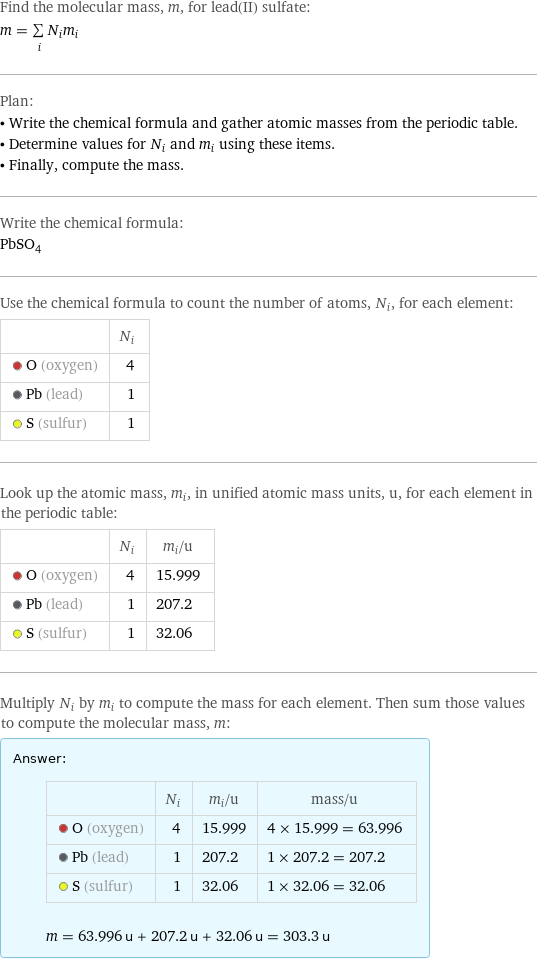Input interpretation

lead(II) sulfate | molecular mass
Result

Find the molecular mass, m, for lead(II) sulfate: m = sum _iN_im_i Plan: • Write the chemical formula and gather atomic masses from the periodic table. • Determine values for N_i and m_i using these items. • Finally, compute the mass. Write the chemical formula: PbSO_4 Use the chemical formula to count the number of atoms, N_i, for each element: | N_i O (oxygen) | 4 Pb (lead) | 1 S (sulfur) | 1 Look up the atomic mass, m_i, in unified atomic mass units, u, for each element in the periodic table: | N_i | m_i/u O (oxygen) | 4 | 15.999 Pb (lead) | 1 | 207.2 S (sulfur) | 1 | 32.06 Multiply N_i by m_i to compute the mass for each element. Then sum those values to compute the molecular mass, m: Answer: | | | N_i | m_i/u | mass/u O (oxygen) | 4 | 15.999 | 4 × 15.999 = 63.996 Pb (lead) | 1 | 207.2 | 1 × 207.2 = 207.2 S (sulfur) | 1 | 32.06 | 1 × 32.06 = 32.06 m = 63.996 u + 207.2 u + 32.06 u = 303.3 u
Unit conversions

303.3 Da (daltons)

0.3033 kDa (kilodaltons)

5.036×10^-22 grams

5.036×10^-25 kg (kilograms)

303.3 chemical atomic mass units (unit officially deprecated)

303.4 physical atomic mass units (unit officially deprecated)
Comparisons as mass of molecule

≈ 0.42 × molecular mass of fullerene ( ≈ 721 u )

≈ 1.6 × molecular mass of caffeine ( ≈ 194 u )

≈ 5.2 × molecular mass of sodium chloride ( ≈ 58 u )
Corresponding quantities

Relative atomic mass A_r from A_r = m_aN_A/M_u: | 303

Molar mass M from M = m_aN_A: | 303 g/mol (grams per mole)

Relative molecular mass M_r from M_r = m_mN_A/M_u: | 303

Molar mass M from M = m_mN_A: | 303 g/mol (grams per mole)